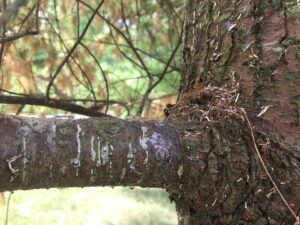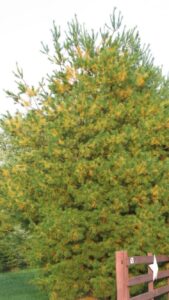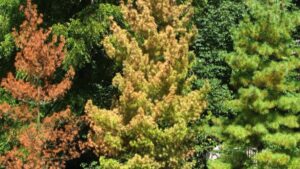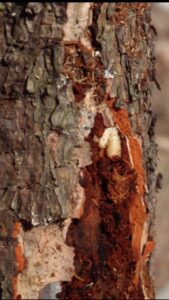Healthy plantings of pines and spruces provide visual screens and lush backdrops that frame outdoor living spaces and provide refuges from the wind. Boring insects can destroy these living shelters by killing trees and turning them into brown skeletons of their former selves. Protect your trees by learning how to recognize early signs of decline to save trees while they are still healthy. Use proper planting and irrigation practices to help your trees thrive in summer and winter. Insecticides that target borers on their way in and out of the tree are tools of last resort.
It is normal for evergreen trees to lose older needles in the spring and fall. The yellow pine needles will be replace by a healthy green canopy as the summer progresses.
Progressive yellowing and browning is typical of pine trees declining due to borers. This photo provides a great visual example of how the problem can spread from sick to healthy trees. The tree on the left with brown needles is completely dead. The yellowing tree in the center is also dying and too late to save. The yellowing older needles on the tree to the right is a normal pattern of needle loss. Remove the declining two trees before borers start flying from the dying trees to protect the healthy tree on the right.

Pine shavings on a branch left from pine sawyer beetles are a sign that your tree may already be dead.
By the time fine wood shavings accumulate on branches and at the base of a tree, the tree can no longer be rescued. Insect borers have already eaten most of the living tissue beneath the bark that moves water and nutrients throughout the tree. At this point, large sections of the bark can be separated from the trunk in sheets.
Dying pine trees harbor and nurture the grub stage of pine sawyer beetles, bark beetles and other borers. If dying infested trees are left standing in the landscape these insects will eventually spread to nearby pine trees and kill them. These borers are especially attracted to trees that did not get enough water in during drought periods.
How to manage borers?
Keep your plants irrigated during the season. This is especially important for new plantings that can become water stressed and attract borers. Be careful not to over water and make conditions favorable to prevent fungal root rots. An inch of rain per week is usually enough. Focus your irrigation efforts on the base of the trees to prevent foliar diseases. Providing adequate spacing between trees can also help reduce fungal leaf infections but don’t expect any miracles with Colorado blue spruce. These trees are too susceptible to disease to expect them to live long in Indiana.
When you remove dying pines and spruces to remove borers, be sure to dispose of the borer-infested wood as soon as possible. This means moving them far away from your property before borers emerge. Technically, you can burn, chip or bury the wood. Legally, however, there are local restrictions on burning and digging. Be sure to follow local ordinances. Call the local utility service (811) before you dig to avoid buried gas and other utility lines.
After you have removed the dying trees, treat the trunk of adjacent trees that are apparently healthy with an insecticide to kill borers as they fly in or out of tree trunks and limbs. Some of these trees may already have borers, in them, but too few to harm tree health. Proper timing of insecticide treatments in mid-April or late August can prevent additional injury and allow trees to recover. Several insecticides like permethrin are commonly available. Soil applications of imidacloprid can also help.
For more information about particular borers and their control please see our bulletin on Borers of pines and other needle bearing evergreens For photos of the different kinds of borers their injury and control get the FREE Tree or Shrub doctor app at PurduePlantDoctor.Com.


